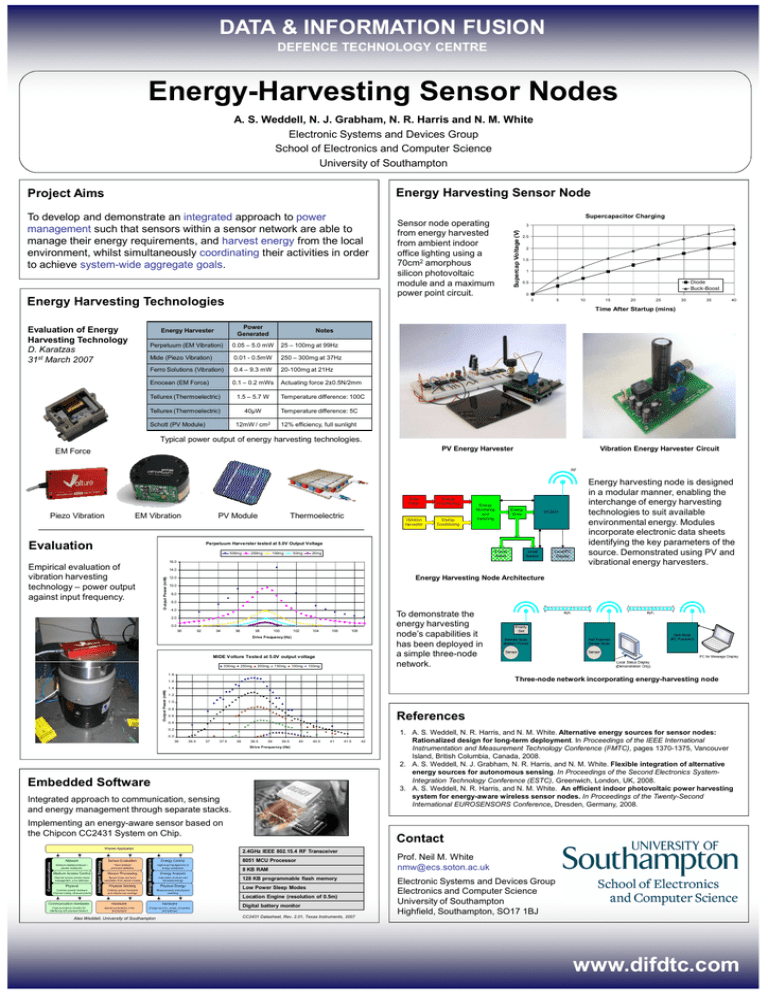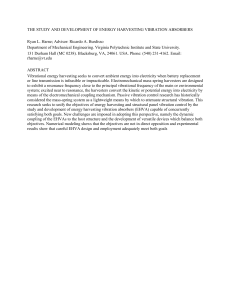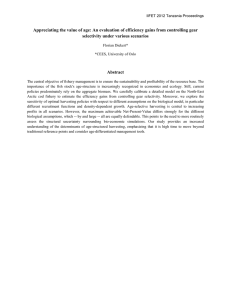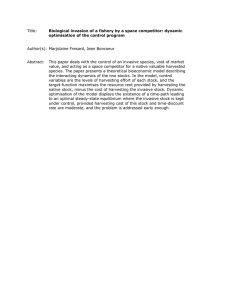Energy-Harvesting Sensor Nodes
advertisement

DATA & INFORMATION FUSION DEFENCE TECHNOLOGY CENTRE Energy-Harvesting Sensor Nodes A. S. Weddell, N. J. Grabham, N. R. Harris and N. M. White Electronic Systems and Devices Group School of Electronics and Computer Science University of Southampton Energy Harvesting Sensor Node To develop and demonstrate an integrated approach to power management such that sensors within a sensor network are able to manage their energy requirements, and harvest energy from the local environment, whilst simultaneously coordinating their activities in order to achieve system-wide aggregate goals. Energy Harvesting Technologies Evaluation of Energy Harvesting Technology D. Karatzas 31st March 2007 Supercapacitor Charging Sensor node operating from energy harvested from ambient indoor office lighting using a 70cm2 amorphous silicon photovoltaic module and a maximum power point circuit. 3 Supercap Voltage (V) Project Aims 2.5 2 1.5 1 Diode Buck-Boost 0.5 0 0 5 10 15 20 25 30 35 40 Time After Startup (mins) Energy Harvester Power Generated Perpetuum (EM Vibration) 0.05 – 5.0 mW 25 – 100mg at 99Hz Mide (Piezo Vibration) 0.01 - 0.5mW 250 – 300mg at 37Hz Ferro Solutions (Vibration) 0.4 – 9.3 mW 20-100mg at 21Hz Enocean (EM Force) 0.1 – 0.2 mWs Actuating force 2±0.5N/2mm 1.5 – 5.7 W Temperature difference: 100C Tellurex (Thermoelectric) Tellurex (Thermoelectric) Schott (PV Module) Notes 40µW Temperature difference: 5C 12mW / cm 2 12% efficiency, full sunlight Typical power output of energy harvesting technologies. PV Energy Harvester EM Force Vibration Energy Harvester Circuit RF Piezo Vibration EM Vibration PV Module Evaluation Solar Panel Energy Conditioning Vibration Harvester Energy Conditioning Energy Monitoring and Switching Energy Store CC2431 Perpetuum Harverster tested at 5.0V Output Voltage 500mg 250mg 100mg 50mg Energy Bleed 25mg Local Sensor Local/PC Display 16.0 14.0 Output Power (mW) Empirical evaluation of vibration harvesting technology – power output against input frequency. Thermoelectric Energy harvesting node is designed in a modular manner, enabling the interchange of energy harvesting technologies to suit available environmental energy. Modules incorporate electronic data sheets identifying the key parameters of the source. Demonstrated using PV and vibrational energy harvesters. Energy Harvesting Node Architecture 12.0 10.0 8.0 6.0 4.0 To demonstrate the energy harvesting node’s capabilities it has been deployed in a simple three-node network. 2.0 0.0 90 92 94 96 98 100 102 104 106 108 Drive Frequency (Hz) MIDE Volture Tested at 5.0V output voltage 300mg 250mg 200mg 150mg 100mg 100mg 1.8 Three-node network incorporating energy-harvesting node 1.6 Output Power (mW) 1.4 1.2 1.0 0.8 References 0.6 0.4 0.2 0.0 36 36.5 37 37.5 38 38.5 39 39.5 40 40.5 41 41.5 Drive Frequency (Hz) Embedded Software Integrated approach to communication, sensing and energy management through separate stacks. Implementing an energy-aware sensor based on the Chipcon CC2431 System on Chip. 1. A. S. Weddell, N. R. Harris, and N. M. White. Alternative energy sources for sensor nodes: Rationalized design for long-term deployment. In Proceedings of the IEEE International Instrumentation and Measurement Technology Conference (I2MTC), pages 1370-1375, Vancouver Island, British Columbia, Canada, 2008. 2. A. S. Weddell, N. J. Grabham, N. R. Harris, and N. M. White. Flexible integration of alternative energy sources for autonomous sensing. In Proceedings of the Second Electronics SystemIntegration Technology Conference (ESTC), Greenwich, London, UK, 2008. 3. A. S. Weddell, N. R. Harris, and N. M. White. An efficient indoor photovoltaic power harvesting system for energy-aware wireless sensor nodes. In Proceedings of the Twenty-Second International EUROSENSORS Conference, Dresden, Germany, 2008. Contact 2.4GHz IEEE 802.15.4 RF Transceiver 8051 MCU Processor 8 KB RAM 128 KB programmable flash memory Low Power Sleep Modes Location Engine (resolution of 0.5m) Digital battery monitor Alex Weddell, University of Southampton 42 CC2431 Datasheet, Rev. 2.01, Texas Instruments, 2007 Prof. Neil M. White nmw@ecs.soton.ac.uk Electronic Systems and Devices Group Electronics and Computer Science University of Southampton Highfield, Southampton, SO17 1BJ www.difdtc.com




